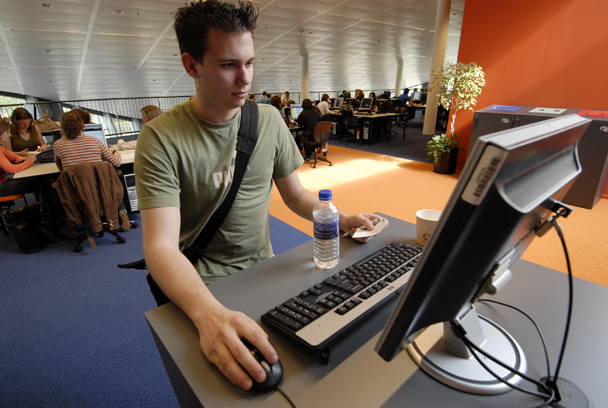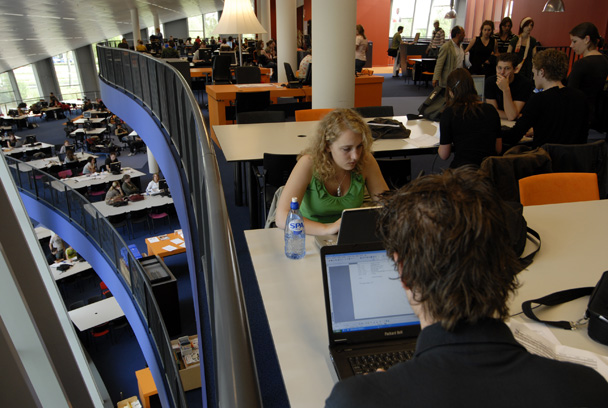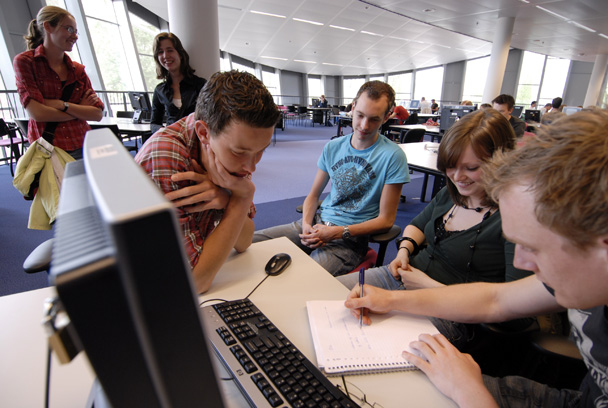Impact on Staff and Students
This paper focuses on the changes in education and their implication for the university library. The impact of Avans’s strategic educational vision on the design and lay-out of the buildings. Especially Xplora, the Learning Centre of Avans, will be described.
The three locations of the Avans Learning Centre (opened up in 2006 and 2007) comprise a total of 2,000 student workplaces. The traditional library has changed into a multimedia learning centre and now resides under the Avans’s Learning and Innovation Centre.
New buildings and a new organisational structure demand new working arrangements with faculty staff. The transformation from library to learning centre and especially the consequences for library staff will be focussed upon. All staff were offered a comprehensive training programme. In addition, information specialists were trained to improve their acquaintance with educational knowledge. The benefits derived from the cooperation between library staff and colleagues from other disciplines (e.g. educational consultants, e-learning consultants, multimedia staff etc.) within the Avans Learning and Innovation Centre will be described. The results of relevant student surveys will also be described. At the end some conclusions will be drawn based on four years of working with new buildings, new educational models, a new organisation, new working arrangements, etc.
Avans is located in three cities in the Netherlands: Breda, Tilburg and Den Bosch. It has 24,000 students, more than 50 bachelor programmes, 2,000 staff, 4 support units and a Learning and Innovation Centre.
Over the past years Avans’s educational model has changed from traditional education to more modern education. Within traditional education the teacher played a central role. There was a passive role for the student in the classroom. Education was subject-oriented. There was limited use of information resources, mostly prescribed textbooks. In this model learning mainly happens at home, outside the classroom and outside the institution. Modern education is more student-centred. Students now have an active role in problem-based learning and project learning. Students formulate their own learning goals and select their own learning resources. Learning is now also happening inside the institution.

Figure 1
In the international context the impact of space on learning is more and more recognised. Diane Oblinger, who presently serves as president of Educause and who is a former president of the Educause Learning Initiative, in 2006 published the important book Learning Spaces (Oblinger, 2006). A central statement in the book is: ‘We know that space can have a significant impact on teaching and learning. Exactly how we bring together space, technology, and pedagogy will continue to evolve.’
In the JISC publication Designing Learning Spaces for Effective Learning, the important influence of learning space on learning is described as follows: ‘Spaces are themselves agents for change. Changed spaces will change practice.’ (JISC, 2006). This is exactly what happened over the last three years within Avans University. Changed spaces clearly changed practices and the motor of these changes was the educational vision.
In all three locations of Avans University, major building activities have taken place. In Breda a combination of old and new buildings was developed, in Den Bosch the existing building was remodelled and in Tilburg a whole new building was created. In each of these buildings there is an ‘Xplora’ (see below). A reshuffling of square metres has taken place within in the buildings. In the new building fewer square meters are available for traditional classrooms and more for student workplaces, for instance in Xplora. At this moment many learning activities are taking place within Xplora, it is very heavily used. Over the past two years more than 2 million students have used Xplora for their learning activities.
Students demand adequate resources to support the learning process: students need computers, rooms for group work and support outside contact hours.
It is also important that library staff take part in the educational process. The traditional library must change into a rich learning environment. It should be an attractive environment where students can also relax, talk, have a drink, etc.
The educational vision of Avans has played an important role in the building projects over the last ten years. As early as 1998 a conference was organised for Avans’s management staff about the educational vision and the impact of this vision on future building projects in Breda.
Key elements of the educational vision of Avans are:
- Connecting people: connecting students, teachers and the professional field; learning is done with each other and from each other, together and individually;
- Recognising diversity;
- Creating knowledge;
- Establishing a dynamic learning environment. The environment should create opportunities for learning.
The name of our learning centre is Xplora. Together with our public relations department it was decided that we did not like the name ‘Learning Centre’ for the buildings. So we came up with the name Xplora!
Xplora includes as many as 2,100 work places (70% for group study and 30% for individual study). In Breda students have 1,100 workplaces, in ‘s-Hertogenbosch 800 and in Tilburg 200. Divided over the three locations we also offer students more than 800 state-of-the-art desktop pc’s. Nowadays students increasingly use their own laptops. That is why all the buildings offer students wireless access for laptops.
We count our visitors to all the Xplora locations on a daily basis. With 24,000 students as the target population, the three Xplora’s have on average 160,000 visitors per month during most of the year. These numbers speak for themselves. Between the hours of 08.00 AM and 15.00 PM all workspaces are fully booked and no vacant study places in Xplora remain. Over the whole year 2009 1.4 million student/teachers visited Xplora.
Is a learning space just a facility or is it a strategic instrument? According to JISC: ‘A learning space should be able to motivate learners and promote learning as an activity, support collaborative as well as formal practice, provide a personalised and inclusive environment, and be flexible in the face of changing needs.’ (JISC, 2006). In our institution too we have come to think of the learning space as a strategic instrument linked to the strategic vision on learning and teaching.
Key elements in the strategic vision according to JISC are: ‘What is important is that designs of physical spaces are linked to the institution’s strategic vision for teaching and learning, and that this is articulated in every detail of the design and shared with all stakeholders, including learners.’ (JISC, 2006).

Figure 2
These strategic choices have led to Xplora being incorporated within the Learning and Innovation Centre and not within the Housing and ICT Department. Within the Learning and Innovation Centre (LIC), staff with different backgrounds like education, e-learning, multimedia and information are working together in multidisciplinary teams advising and supporting academies. Thus within the LIC different disciplines work together interacting with and working with the rest of the Avans organisation. This is essential to our approach.
The use of modern educational concepts within Avans changes the role Xplora plays: the learning centre must play a much more important role in achieving educational goals. The position of the learning centre with regard to education is therefore changing from the side-line to a position at the centre of the process. By setting up a new partnership relation with school faculty, l staff are in a better position to sell their services to costumers. Also, by knowing exactly what is happening in a course, learning centre staff are better equipped to help students with their questions and problems.
Strong ties with school faculty are crucial for adequately connecting services with users’ wishes. To meet the needs of the school faculty, good working relations between the learning centre and the schools must be built and maintained.
A new position, that of information specialist, comparable to educational officers from the Learning and Innovation Centre, was created. Both officers support educational development and delivery. This means that the position of the former Library with regard to education has changed in a fundamental way. The traditional library has merged into the Learning and Innovation Centre.
A new educational concept and new buildings require new working arrangements and new staff supporting the learning process.
In institutions of higher education there is no tradition of collaboration between school faculty on the one hand and library/learning centre staff on the other. Traditionally both education and learning centre have their own focus. Of course from time to time the two parties meet, but in general, lecturers and learning centre staff have their own goals; there is no collaboration between the two groups in course delivery and course design. Learning centre staff do not actively participate in course design and course delivery. Due to this lack of active involvement by educational staff in collection development by the learning centre, study materials that students look for frequently are not available in the learning centre. Only when students appear at the Xplora desk are learning centre staff confronted with these special questions and information needs. In such a situation learning centre staff will frequently not be able to provide the correct answers and resources. With the new educational model and the new Xplora buildings with lots of workspaces, this leads to vital information resources not being available in the learning centre when students need them.
It is crucially important that learning centre staff and school faculty should cooperate much more intensively, not only in course delivery but also in course design.
Within the learning centre, new working arrangements with school faculty were made and every member of staff received a new job description. A comprehensive staff training programme for learning centre staff was also developed:
-
Regular and visible contact persons for school faculty were assigned to each school.
-
In this way each school was assigned a team of subject-librarians and information specialists, specialised in the subject area of the school in question.
-
The information specialists received additional training (specifically in school-related matters) allowing a pro-active approach to schools’ wishes with regard to learning centre facilities.
-
The information specialist works together with the Innovation Centre staff in education-development teams within schools, thereby improving the quality of the information supply.
-
User research and feedback groups were introduced.
The primary task of the information specialist is to translate the school’s needs and requirements for the learning centre. Another important task is to advise schools on the possibilities of the learning centre to support educational activities. Information specialists also contribute to strengthening the role of the LIC by giving presentations, promoting products and services and giving instructions.
The relation with the student is changing. Learning centre staff are more active in supporting the learning process of the student. Due to the reduced number of contact hours students work more independently. Xplora offers facilities for all teacher-unrelated activities that are central to today’s curriculum. The information needs of the student change. There is not only a greater demand for information and ICT assistance, but when teachers are not available, there are more subject-related questions. The relation with the teachers is also changing. Information specialists, for example, participate in curriculum development teams.
As a result of the changing role in supporting students and teachers, learning centre staff need new competencies and a new division between existing positions. New job descriptions were drafted and a comprehensive training programme was designed for all staff:
-
Foremost learning centre staff had to acquire more knowledge about education. Almost all the librarians in higher educational institutions in the Netherlands and maybe in the whole of Europe, have an urgent need for more knowledge about education. If the staff of the learning centre wants to be a real partner to the school faculty, they must have a basic knowledge of education. And an information specialists require more than basic knowledge of education if they are to serve the schools well.
-
All staff had to develop their advisory abilities.
-
Not only new ICT trends like wiki’s, weblogs, google-scholar/print were part of the training programme, but also digital collection development, search engines, digital rights management etc. This training programme was set up in cooperation with the Library school of Avans Hogeschool. As all staff became students themselves for a period of six months, they received hands-on experience with the educational system.
-
All staff were trained in the culture shift from control-directed to student-directed, result-oriented and customer-directed.

Figure 3
In 2004 a staff formation plan for the period 2005–2008 was written by the LIC management. This plan described the staff development required for the transition period of the formal library transforming into a new learning centre. All consequences for staff composition, quantitatively as well as qualitatively were assessed. At the time there were already plans for building learning centres on our three locations. The new learning centres were to have long opening hours. These long opening hours were the main reason that in the staff formation plan 2005–2008 an increase in staff was foreseen from 35 fte to 53 fte.
In 2005 new job descriptions were drafted with team members, followed by a reorganisation at the end of 2005. In September 2005 the Board of our university approved the staff formation plan for the period 2005–2008 including an increase in staff by 18 fte. In 2005 a training programme for all staff was started and much effort has gone into the training of staff members until the present day. When the new learning centres were opened in 2006/2007, staff started in their new jobs after having completed a comprehensive training programme that lasted six months.
During reorganisation all staff were asked to indicate which position they would like to fill in the future. Only librarians could apply for the position of information specialist.
With the support of the Board the learning centre is now in the process of drafting an investment plan for further major improvement to our three Xplora’s next year. Xplora is now well-known in the Netherlands and it wants to continue developing, for standing still means going backwards. In September 2010 a teachers centre will be opened in Xplora. In addition, a new student centre for peer-mentoring and peer-tutoring activities is planned for 2011. Also, a Mobile Learning Support pit for supporting students and teachers with their laptops will be established, as well as a reading café, more quiet area’s, video walls, etc. Xplora Den Bosch is going to expand with more than 400 workspaces in 2012. And last but not least the design process of a new technical Xplora has been started in close cooperation with our technical schools. The opening of this technical Xplora is planned for 2012.
In 2009 the Learning and Innovation Centre started adopting Key Performance Indicators (KPI) for the organisation and also for the individual teams. A ‘dashboard’ system was implemented to link the staff working-hours registration system to budgeted activities. This is a kind of activity-based costing system designed to generate an objective picture of the flow of our resources in practice in terms of working hours spent on different activities.
The occupation rate of study work spaces is very high, especially between 08.00 AM and 16.00 PM. During other hours plenty of pc work places are available and it is much less crowded. One explanation for this is that students often still live with their parents and want to be home for dinner.
One of the outcomes of our surveys is that a clear majority of students think there are not enough regular pc work places and outlets available. We already have 2,000 work places available in the three Xplora’s for students and more than 800 of them are equipped with a pc. Also the whole building has wireless access and many students use their own laptops. As mentioned before we receive a high number of visitors. Another outcome was that students want more workspaces for quiet study (silence workspaces).
It also became clear that Xplora is mostly used for group work and pc applications. Students indicated that they liked the study place as an attractive and inviting learning environment. During the building process special attention was paid to just this aspect, as well as to noise management. The high level of service is also a good indication of the success of the Avans concept. Lastly, there is a high demand for teachers to be present in Xplora because students like to ask them questions when they are working there.
Collaboration between traditional library staff from the learning centre and educational officers from the Innovation centre proved to be of mutual benefit:
-
Library staff now have more appreciation for educational processes.
-
Through collaboration educational officers have gained improved understanding of the relationship between information and knowledge.
On the whole can be concluded that Xplora to a high degree serves the needs of the students. Xplora is widely known even outside the professional field. Xplora continually receives lots of visitors, not only from Netherlands but also from other countries.
A lot of effort is still devoted to staff training, especially in e-learning, Web 2.0, advisory skills and negotiating techniques, educational knowledge and a broader knowledge of the learning environment. The culture shift within the Avans community proves to be a very time-consuming process.
It is important to involve staff in major developments. The Learning and Innovation Centre’s staff are actively participating in setting up the new Businessplan for 2011. They are also closely involved in all the activities aimed at further developing Xplora, for instance in the building activities.
It is crucial that the centres continue to develop their services in close cooperation with our stakeholders because ‘standing still is going backwards’.
As a result of introducing the KPI and timesheets linked to our activity budgets, there is more objective information available about our own organisation.
|
JISC (2006): Designing Spaces for Effective Learning: A Guide to 21st Century Learning Space Design, JISC, http://www.jisc.ac.uk/media/documents/publications/learningspaces.pdf.
|
|
Oblinger, Diana G. (ed.) (2006): Learning Spaces, EDUCAUSE, http://www.educause.edu/LearningSpaces.
|